Lettuce is one of the easiest and most healthy vegetables to grow in the USA. You can successfully grow Lettuce in your garden with little care and attention. Lettuce can be grown in all 50 states of the USA. It is one of the most popular salad greens and is used in many cuisines worldwide.
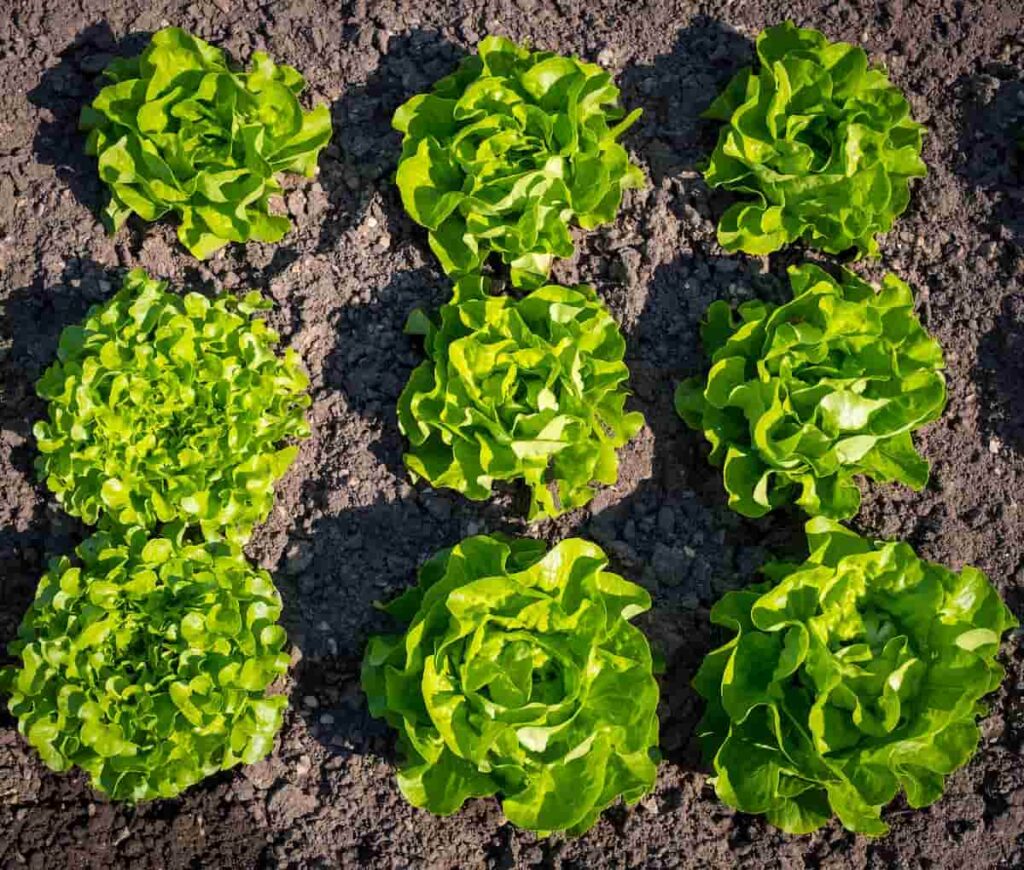
How to grow Lettuce in the USA
Soil requirement for growing Lettuce in the USA
Lettuce is a cool-weather crop that can be grown throughout the year in most areas of the United States. The main soil requirement for growing Lettuce is that it must be well-drained. Lettuce does not like to sit in wet or soggy soil, so it is essential to ensure your planting area has good drainage. Lettuce also prefers slightly acidic soil with a pH level of 6.0 and 7.0. If your soil is not naturally acidic, you can add sulfur to lower the pH.
Lettuce growing conditions in the USA
- Lettuce is a cool-weather crop and thrives in moist, well-drained soil. It can be grown in partial shade or full sun.
- Lettuce is typically planted in the United States in late winter or early spring as soon as the ground can be worked. Lettuce can also be planted in late summer for harvest in the fall.
- Lettuce seeds are very small, so they must be sown on the soil surface and lightly covered with sand or vermiculite. The seeds will germinate in 7 to 10 days.
- Once the Lettuce seedlings have emerged, thin them out and space them about 12 to 18 inches apart. Lettuce is ready to harvest when the leaves are crisp and tender. Depending on the variety, this can take anywhere from 21 to 60 days after planting.
Lettuce varieties in the USA
- Iceberg: This is the most common type of Lettuce in the USA. It has a crisp, crunchy texture and a mild flavor.
- Romaine: Romaine Lettuce is characterized by its long, narrow leaves. It has a bitter taste and a chewy texture.
- Butterhead: Butterhead Lettuce has soft, delicate leaves. It has a sweet, buttery flavor that is perfect for salads.
- Red Leaf: Red leaf Lettuce is distinguished by its deep red color. It has a slightly spicy flavor and a crisp texture.
- Green Leaf: Green leaf Lettuce is the most versatile type of Lettuce. It can be used in salads, sandwiches, or as a side dish.
- Leaf Lettuce: This type of Lettuce has loose, bright green leaves. It is often used in salads or as a wrap ingredient.
In case you missed it: Growing Lettuce In Pots, Containers, and Backyards At Home
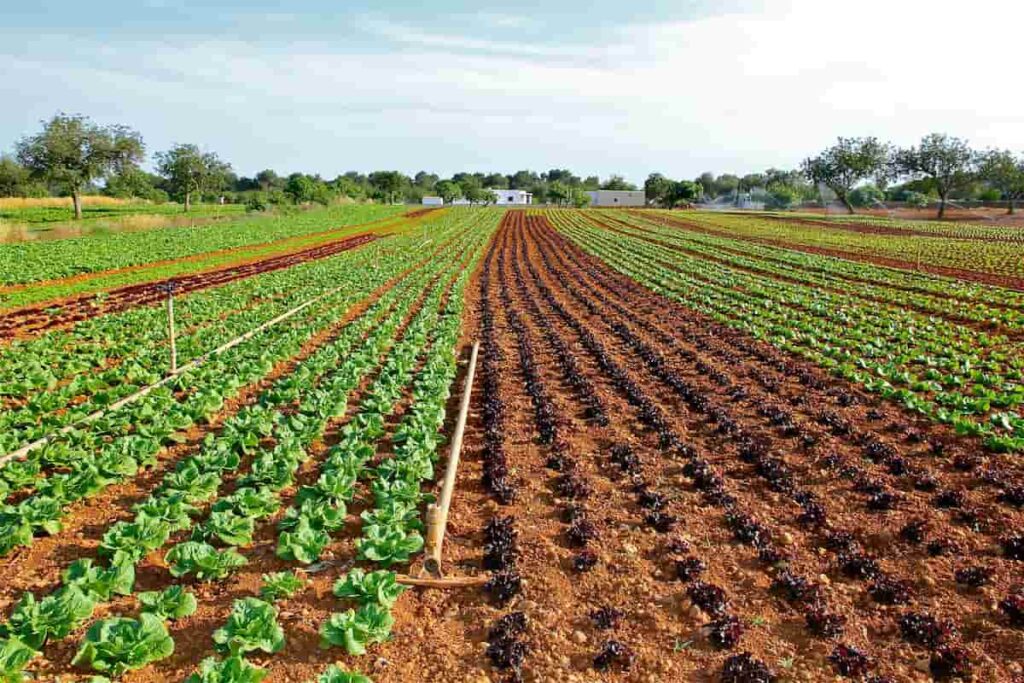
Lettuce plant care tips
- Commercial Lettuce production in the USA is a multi-million-dollar industry. The country produces a variety of Lettuces, including iceberg, romaine, and leaf varieties. Regarding yield, California accounts for around 70% of the total Lettuce production in the United States.
- Lettuce is a cool-season crop typically grown in regions with mild winters. In the USA, commercial Lettuce production occurs in states such as California, Arizona, and Texas. Lettuce can be grown in many soils, but well-drained loamy soils are ideal.
- Propagation is usually done by seed. Seeds are sown in trays or flats filled with moistened potting mix. Once the seedlings have emerged, they are transplanted into the field.
- Care of commercial Lettuce crops includes regular irrigation and fertilization. Pest and disease control is also important to ensure a high yield and quality product. Lettuce is typically harvested by hand when the heads are mature and before they start to bolt (produce flowers).
How to propagate Lettuce?
Lettuce is a cool-weather crop that can be grown in most regions of the United States. The soil should be loose, well-drained, and rich in organic matter. Lettuce can be started from seed or transplants. The primary methods of propagating Lettuce are by seed and by division.
Seed propagation is the most common method of Lettuce propagation. It’s also the fastest and easiest way to get started. All you need is a packet of Lettuce seeds and some potting soil. To sow your seeds, fill a pot with potting soil and sprinkle the seeds on top. Then, lightly water them and place the pot in a warm, sunny spot. Once your seedlings have their first true leaves, you can thin them out so that only the strongest plants remain. From there, you can transplant your seedlings into individual pots or your garden bed.
The division is another popular method of propagation, particularly for heirloom varieties of Lettuce that are hard to find as seeds. To propagate by division, dig up an existing plant and carefully divide it into two or more sections, ensuring each section has a good root system. You can then replant these sections in separate pots or areas of your garden.
Lettuce farming tips
- One of the most popular crops in America, Lettuce is easy to grow and can be done in any region of the country. Whether growing it for yourself or at a farmer’s market, there are a few key things to remember when growing Lettuce.
- The first is that soil is key. Lettuce prefers loose, well-drained soil with a neutral pH. If your soil is too compacted or has a high clay content, it must be amended before planting. You can amend the soil by adding organic matter like compost or peat moss.
- Once your soil is ready, you’ll need to choose a propagation method. Lettuce can be started from seed, transplants, or cuttings. Starting from seed is the cheapest option, but it does require more patience as it takes longer for the seeds to germinate and the plants to mature. Transplants are young plants that have already been started from seed and can be purchased at most garden centers. Cuttings are another option and can be taken from an existing plant.
In case you missed it: Hydroponic Lettuce Farming In Greenhouse For Beginners
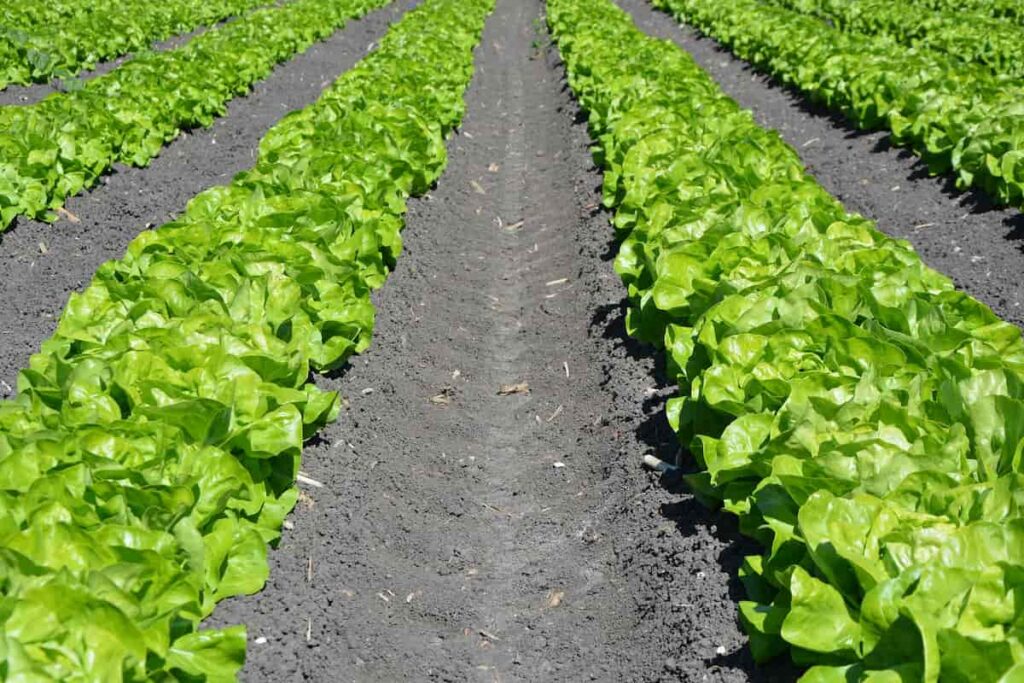
How to grow Lettuce in containers?
- Lettuce is a cool-weather crop that can be grown in containers year-round in most parts of the United States. It is one of the easiest vegetables to grow and only takes a few weeks from seed to harvest.
- You will need a container at least 12 inches deep with drainage holes. Fill the pot or container with a quality potting mix, and then sow your seeds or transplant young plants. Lettuce prefers full sun, but it also grows well in partial shade.
- Water the plant regularly to keep the growing soil moist but not soggy, and fertilize with liquid plant food every few weeks. Head Lettuce varieties will mature in about 60 days, while leaf Lettuces will be ready to harvest in about 30 days.
- To harvest, cut off the outer leaves as needed, careful not to damage the inner leaves or crown. With regular harvesting, your Lettuce plants should continue producing for several months.
Lettuce fertilizer requirements
Lettuce is a relatively easy crop to grow, but there are a few points regarding fertilizer requirements.
- Firstly, Lettuce is a cool-season crop, so the plant should be fertilized in early spring or late fall.
- Second, because Lettuce is a shallow-rooted plant, it doesn’t need a lot of fertilizer. Too much fertilizer can harm plants.
- Third, when choosing a fertilizer for Lettuce, look for one that is low in nitrogen and high in phosphorus and potassium. A well-balanced fertilizer like 10-10-10 or 8-8-8 will work well. Fourth, apply the fertilizer at the rate recommended on the package label.
- Finally, remember that organic fertilization methods (like compost) are always best for plants and the environment.
Lettuce growing areas in the USA
- Lettuces are the most valuable US vegetable, including head (iceberg) and leaf (romaine, butterhead, baby, and other leaf types). Most US Lettuce is produced in California (70 percent of US production) and Arizona (30 percent).
- Lettuce is a popular vegetable in the United States, and California produces a large portion of the country’s Lettuce crop. The state’s mild climate and ample sunlight make it an ideal place to grow this leafy vegetable.
- The three main lettuce-growing areas in the United States are the Salinas Valley of California, the Arizona desert, and central Florida. Each has its unique climate and soil type, which affects the type of Lettuce that can be grown there.
- In the Salinas Valley, a cool maritime climate and sandy loam soil allow a wide variety of Lettuce to be grown, including iceberg, romaine, and leaf varieties. In addition, the long growing season means that Lettuce can be harvested year-round.
- The Arizona desert has a hot, arid climate and sandy soil. This combination is ideal for growing crisphead Lettuce, such as iceberg and romaine. The heat helps the Lettuce to form a tight head, while the sand prevents it from getting too wet and rotting.
- Central Florida has a subtropical climate with sandy soils. This climate is well suited for growing leafy greens like spinach, kale, and Swiss chard. The warm weather allows these greens to grow year-round, with multiple harvests possible per year.
In case you missed it: Earn Excellent Income Returns from Lettuce Farming
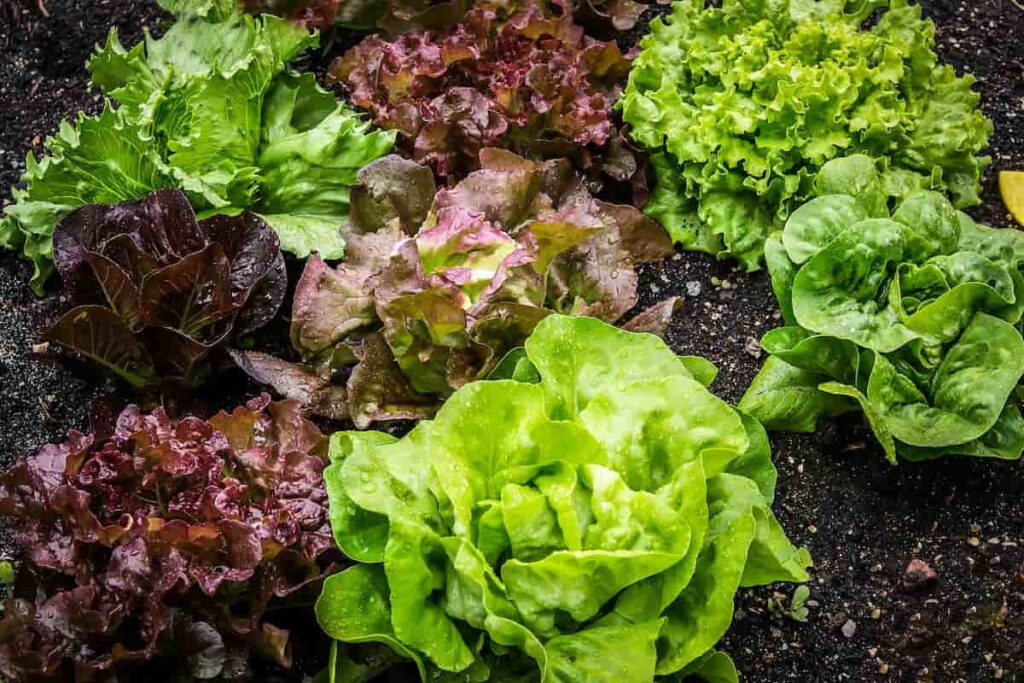
Lettuce growing tips from seed
Lettuce is easy to grow from seed. You can start Lettuce seeds indoors or outdoors, and with a little care, you can have a bountiful harvest of fresh greens in no time. Below are some tips for growing Lettuce from seed;
Step 1: Starting Seeds Indoors
If you start your Lettuce seeds indoors, you will need to provide them with plenty of light. You can either use artificial lighting or place them near a sunny window. The soil should be loose and well-drained, and you should water the seeds regularly to stay moist but not soggy once the seeds have sprouted, thin them out so that only the strongest seedlings remain.
Step 2: Transplanting Seedlings
When transplanting seedlings outdoors, choose a location with plenty of sunlight and loose, well-drained soil. Water the seedlings well before transplanting them, and then carefully dig holes that are big enough to accommodate the roots without crowding them. Gently lower the seedlings into the holes and firmly press the soil around them. Water again after planting.
Step 3: Caring for your Lettuce plants
Once your Lettuce plants are established, they will need regular watering (about 1 inch per week), especially during hot weather. Apply a layer of mulch around the Lettuce plants to help retain moisture in the soil.
Lettuce growing problems
As you know, Lettuce is a cool weather crop. In the heat of summer, the days are longer, and the sun is more intense. This causes the leaves of Lettuce to grow faster and produce more chlorophyll. Chlorophyll gives plants their green color. As the temperature rises, the amount of chlorophyll in the leaves increases. This makes the Lettuce leaves look very dark green or even black in some cases. It can affect the Lettuce flavor.
Lettuce exposed to high temperatures for extended periods will often taste bitter. To avoid this problem, you must try to grow your Lettuce in cooler temperatures. If it’s impossible to keep your Lettuce plants cool, you can still harvest them before they get too hot. Just be sure to check the leaves for color change and flavor before you serve them.
In case you missed it: How to Grow Lettuce at Home with Seeds and Without Seeds
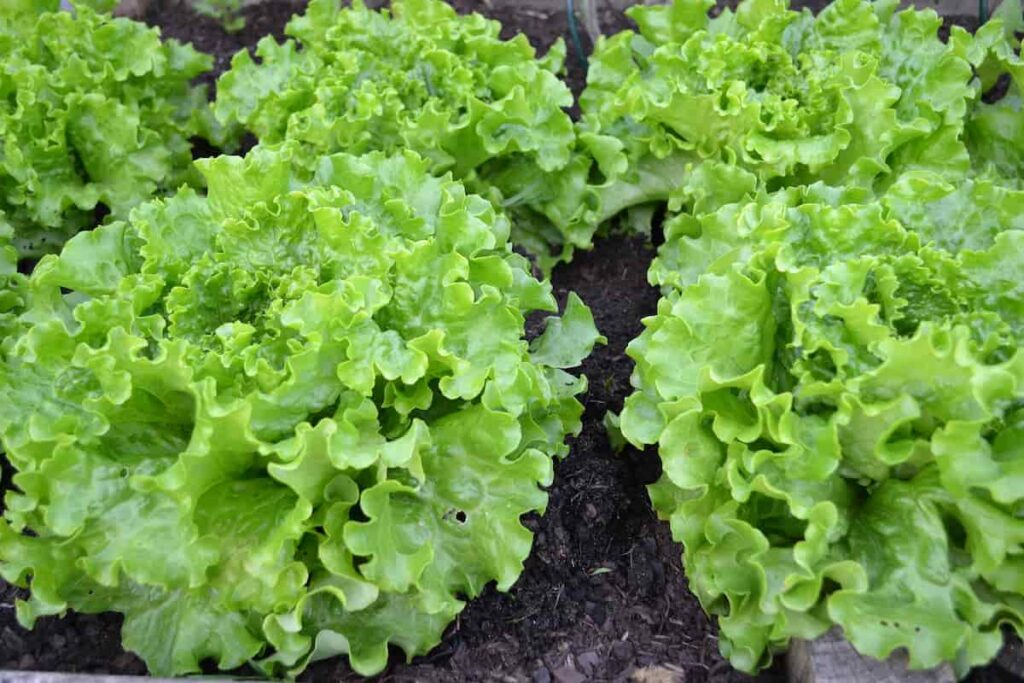
Lettuce pests, diseases, and their control in the USA
Leafy greens like Lettuce are popular crops in home gardens and on small farms. Lettuce is typically grown in spring and fall in the United States, although it can be grown year-round in some regions. The most common pests are aphids, slugs, and caterpillars. The most common diseases are downy mildew and the Lettuce mosaic virus. Pests and diseases are the biggest problems when growing Lettuce in the USA. The most common pests are aphids, caterpillars, and whiteflies.
These pests can be controlled with insecticides, but reading the label carefully and following the directions is essential. Lettuce pests and diseases are relatively easy to control with proper management practices. The most common pests include aphids, caterpillars, slugs, and whiteflies. Aphids can be controlled with insecticidal soap or neem oil. Caterpillars can be controlled with Bacillus thuringiensis (BT) or spinosad. Slugs can be controlled with metaldehyde baits or iron phosphate baits.
Whiteflies can be controlled with insecticidal soap, neem oil, or pyrethrin. Fungi or bacteria typically cause diseases in Lettuce. The most common diseases include downy mildew, bacterial leaf spot, and fusarium wilt. Downy mildew can be controlled with fungicides such as mancozeb or chlorothalonil. Bacterial leaf spots can be controlled with bactericides such as copper hydroxide or streptomycin. Fusarium wilt can be controlled with fungicides such as metalaxyl or mefenoxam.
There are several methods to control pests and diseases in Lettuce crops:
- Use row covers or screens to keep insects from getting to the plants;
- Apply insecticidal soap or neem oil.
Lettuce growing tips for more yield
- Lettuce grown for more yield is typically grown in larger fields and is managed differently than Lettuce grown for fresh markets.
- Growing Lettuce for more yield is to produce a larger quantity of leaves per plant. This is typically achieved by using higher levels of nitrogen fertilizer, growing plants closer together, and providing irrigation during dry periods.
- Harvesting is also done differently for Lettuce grown for more yield; the leaves are cut close to the ground, and the plants are allowed to regrow before being harvested again.
- Although this type of Lettuce typically has a lower nutritional value than other types, it can be a good option for those looking to produce large quantities of Lettuce.
When and how to harvest Lettuce in the USA?
Lettuce can be harvested as soon as the leaves are large enough to eat, usually about 4-6 weeks after planting. The best time to pick Lettuce is in the morning. Lettuce harvested in the early morning is crisper and has a higher water content than Lettuce harvested later in the day. To harvest Lettuce, cut the heads of Lettuce off at the base with a sharp knife.
Be sure to leave enough of the stem attached, so the head does not fall apart. Once you have harvested your Lettuce, it is essential to wash it thoroughly and then store it in a cool, dry place. Lettuce that is stored properly will last for several days.
In case you missed it: Top 19 Steps/Ways/Methods to Boost Lettuce Yield: How to Increase Production, and Quality
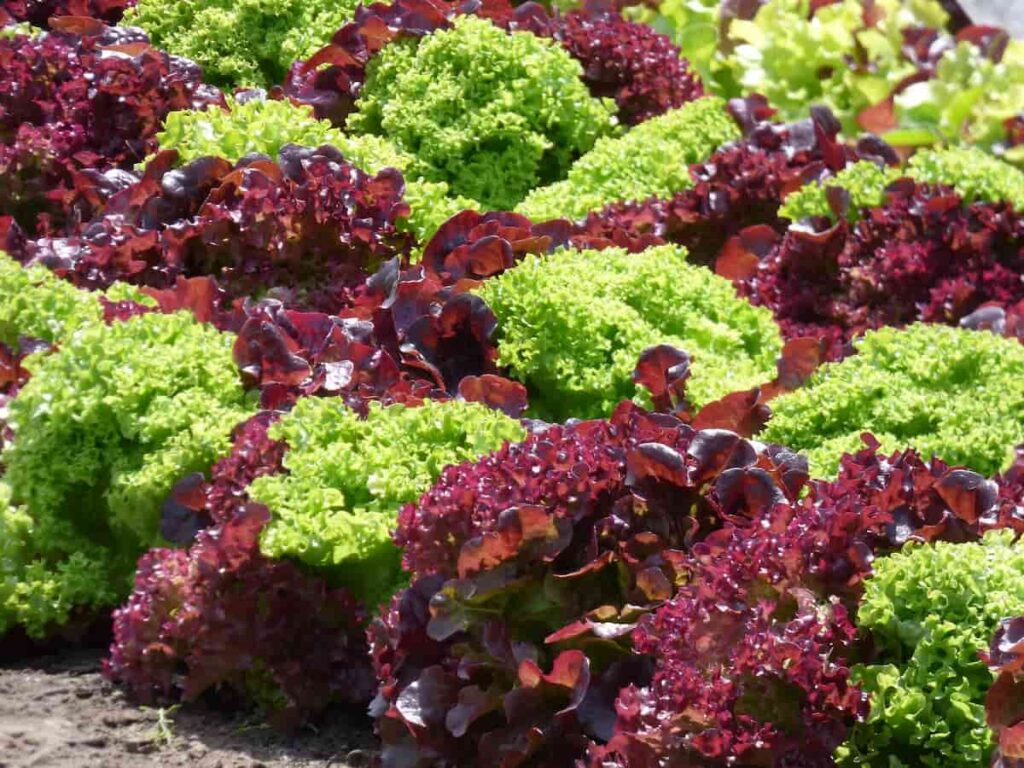
Tips for harvesting Lettuce
- Cut the outer leaves first. This will encourage the plant to produce more leaves.
- Use a sharp knife or garden shear to cut the leaves at the base of the plant.
- Avoid bruising or damaging the leaves when handling them.
- Wash Lettuce immediately after harvest to remove any dirt or debris.
- Store in a cool, dry place until ready to use.
Conclusion
The USA is one of the leading producers of Lettuce in the world. California produces about 80% of the Lettuce grown in the US. Lettuce is a popular leafy green vegetable used in salads, sandwiches, and wraps. It is a cool-weather crop that can be grown in the spring and fall. Lettuce is a relatively easy crop to grow in the United States.
- How to Build a Low-budget Goat Shed: Cheap Ideas and Tips
- Goat Farming Training Programs in India: A Beginner’s Guide
- Types of Pesticides Used in Agriculture: A Beginner’s Guide
- Economical Aquaculture: A Guide to Low-Budget Fish Farming
- 15 Common Planting Errors That Can Doom Your Fruit Trees
- How to Make Houseplants Bushy: Effective Tips and Ideas
- Innovative Strategies for Boosting Coconut Pollination and Yield
- Pollination Strategies for Maximum Pumpkin Yield
- The Complete Guide to Chicken Fattening: Strategies for Maximum Growth
- Natural Solutions for Tulip Problems: 100% Effective Remedies for Leaf and Bulb-Related Issues
- Revolutionizing Citrus Preservation: Towards a Healthier, Greener Future
- Natural Solutions for Peony Leaf and Flower Problems: 100% Effective Remedies
- Maximizing Profits with Avocado Contract Farming in India: A Comprehensive Guide
- Natural Solutions for Hydrangea Problems: 100% Effective Remedies for Leaf and Flowers
- The Ultimate Guide to Choosing the Perfect Foliage Friend: Bringing Life Indoors
- From Sunlight to Sustainability: 15 Ways to Use Solar Technology in Agriculture
- The Ultimate Guide to Dong Tao Chicken: Exploring from History to Raising
- The Eco-Friendly Makeover: How to Convert Your Unused Swimming Pool into a Fish Pond
- Mastering the Art of Delaware Chicken Farming: Essentials for Healthy Backyard Flocks
- 20 Best Homemade Fertilizers for Money Plant: DIY Recipes and Application Methods
- How to Craft a Comprehensive Free-Range Chicken Farming Business Plan
- Brighten Your Flock: Raising Easter Egger Chickens for Beauty and Bounty
- How to Optimize Your Poultry Egg Farm Business Plan with These Strategies
- Subsidy for Spirulina Cultivation: How Indian Government Schemes Encouraging Spirulina Farmers
- Ultimate Guide to Raising Dominique Chickens: Breeding, Feeding, Egg-Production, and Care
- Mastering the Art of Raising Jersey Giant Chickens: Care, Feeding, and More
- Ultimate Guide to Raising Legbar Chickens: Breeding, Farming Practices, Diet, Egg-Production
- How to Raise Welsummer Chickens: A Comprehensive Guide for Beginners
- How to Protect Indoor Plants in Winter: A Comprehensive Guide
- Ultimate Guide to Grow Bag Gardening: Tips, Tricks, and Planting Ideas for Urban Gardeners
- Guide to Lotus Cultivation: How to Propagate, Plant, Grow, Care, Cost, and Profit
- Agriculture Drone Subsidy Scheme: Government Kisan Subsidy, License, and How to Apply Online
- Ultimate Guide to Raising Araucana Chickens: Breed Profile, Farming Economics, Diet, and Care
- Bringing Hydroponics to Classroom: Importance, Benefits of Learning for School Students
- Ultimate Guide to Raising Polish Chickens: Breed Profile, Farming Economics, Diet, and Care
- Ultimate Guide to Raising Australorp Chickens: Profile, Farming Economics, Egg Production, Diet, and Care